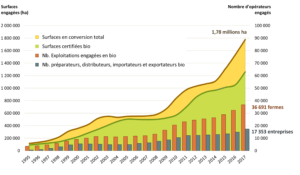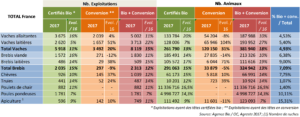Organic production in France continued its rapid increase both in the farming sector and the organic processing sector in 2017. Organic Production in France was greatly aided by the strong growth in the French domestic organic market French producers were able to supply 69% of domestic demand,
French organic agriculture out performs the trend
In 2017, it is estimated that the organic sector accounts for nearly 134,500 direct jobs (organic farm jobs and those related to processing and distribution activities), an increase of 16,500 from 2016. There have 49,200 direct jobs created since 2012 in the organic sector, with an average annual growth of + 9.5% over the past five years.
While agricultural employment fell at an average annual rate of -1.1% between 2010 and 2015, employment in organic agricultural production increased by 10,669 full-time jobs between 2017 and 2016, or +13, 7%.
French Organic production grows to meet consumer demand
As I wrote about here, French Organic Market 2017, the French domestic market continues to increase rapidly.
To meet this demand, as well as growing demand from other EU countries the French organic agricultural sector continues to our perform the general agricultural trends.
As of December 31, 2017, 54,044 organic agricultural workers were engaged in organic farming, or + 14.7% increase in one year.
Of these workers, 36,691 are producers (4,425 additional farmer in one year, or + 13.7% compared to 2016), bringing the share of French farms engaged in organic farming to 8.3%.
In 2017, more than 5,000 farms are involved in organic farming. At the same time, the proportion of producers ceasing their organic certification has decreased and represents 3.5% of organic producers engaged in 2016.
Processing, distribution or import companies accounted for 17,353 operators (or +2,513 operators or + 17% compared to December 31, 2016), including:
– 12,286 transformers (+ 15.9%)
– 4,783 distributors (+ 19.1%)
– 284 importers (+ 27.4%)
The land that went into organic transition in 2015 has now come online as certified organic producers.
By the end of 2017 1,777,727 ha or agricultural land was certified organic or in transition, an increase of + 15.6% compared to 2016.
Of these, 1,259,464 ha are now fully certified organic. This increase of + 19.4% in relation to 2016 it is the result of the entry into fully certified organic production of land, especially cereals and animal fodder that went into transition in 2015.
Quick note on organic certification and the transition period. most farmers moving from industrial agriculture to,organic farming have to go through a transition period. You can’t wake up one morning and decide that tomorrow you are going to be organic. The process and time period varies from sector to sector, the rules are different for say a want to be aromatic plant grower to a cereal grower. As a general rule of thumb it takes three years to transition, the first two you cannot use the term organic to describe your production. I will write bout this some time, probably in winter when I have more time on my hands, it gets a bit tricky
The 20% increase in organically certified agricultural land caused by the large movement into organic agriculture in 2015 has incrased organic production across most sectors. Animal fodder has increased but the tar is vegetable production which has seen a massive increase. Organic wine, which slowed down dramatically in 2016 has also seen a new impetuous. New organic cereal production has seen a shift away from animal foods to more high value human orientated production.
Organic Animal and Poultry Sectors
In line with 2016 these sectors have seen strong growth in 2017
– The number of cows raised in organic farming rose by 18%, with a particular dynamism on dairy farms, which account for nearly 194,000 organic cows, up 27% versus 2016.
The poor growth of fodder in 2016 had led to a decrease organic milk production in 2016 and early 2017 (-0.1% in 2016 versus 2015 according to the summary of the monthly dairy survey). It was offset in 2017 by the entry into organic production of livestock converted in 2015 and a more favorable climate:
the collection of organic milk has increased +13.6% in 2017 versus 2016.
– Maintaining the number of new breastfeeding conversions and strong dairy commitments also occurred for sheep farming. Essentially in their traditional areas, organic dairy ewes numbered 111,616 or 19% relative to 2016.
– The goat herd, slightly behind other dairy farms, is still up 14%.
– The poultry sector has also grown. In 2017, the increase in poultry numbers exceeded that of 2016 (+ 12.5% versus 2015) with + 16.3% for broilers and + 14.3% for laying hens.
– Pig farms are gaining momentum with a 14% increase in sow herds, which should continue in 2018 because of commitments made to improve conditions in the industry in États Généraux de l’Alimentation
Organic Production in France by Region
Organic land is growing in all regions, particularly in Corsica, the Hauts-de-France and New Aquitaine, with growth exceeding +20%.
The large scale organic conversions in 2015 which entered into organic production in 2017, resulting in double-digit increases in organically certified land between 2016 and 2017 for all regions except Brittany.
These developments were particularly marked in the Occitanie (+ 33%), Corsica (+ 26%), New Aquitaine (+ 24%) and Bourgogne-Franche-Comté (+ 22%) regions.
The Provence-Alpes-Côte d’Azur region remains the French region with the largest percentage of farm land under organic production, exceeding 20%. It is followed by our wonderful Occitanie region with 13.4% and Corsica with 10.9%.
As in 2016, nearly 60% of organic farms and land are located in four regions:
– Occitanie 8 164 farms, 422 319 ha
– Auvergne-Rhône-Alpes 5,377 farms, 235,641 ha
– New Aquitaine 5,327 farms, 227,352 ha – Pays de la Loire 2,927 farms, 171,081 ha
These same regions represent more than 40% of certified organic processing and distribution companies. The Ile-de-France and Provence-Alpes-Côte-d’Azur regions, which are densely populated, also play an important role in downstream organic farming. The Ile-de-France region shows very strong commitments from its downstream operators, which are up 30%, followed by the Auvergne-Rhône-Alpes, New Aquitaine, Occitanie and Provence-Alpes-Côte d’Azur regions. Azur which have fairly similar development, between + 13% and + 17%.
To download the full Agence Bio Report on Organic Production in France >> Télécharger l’ensemble des figures du dossier au format HD




